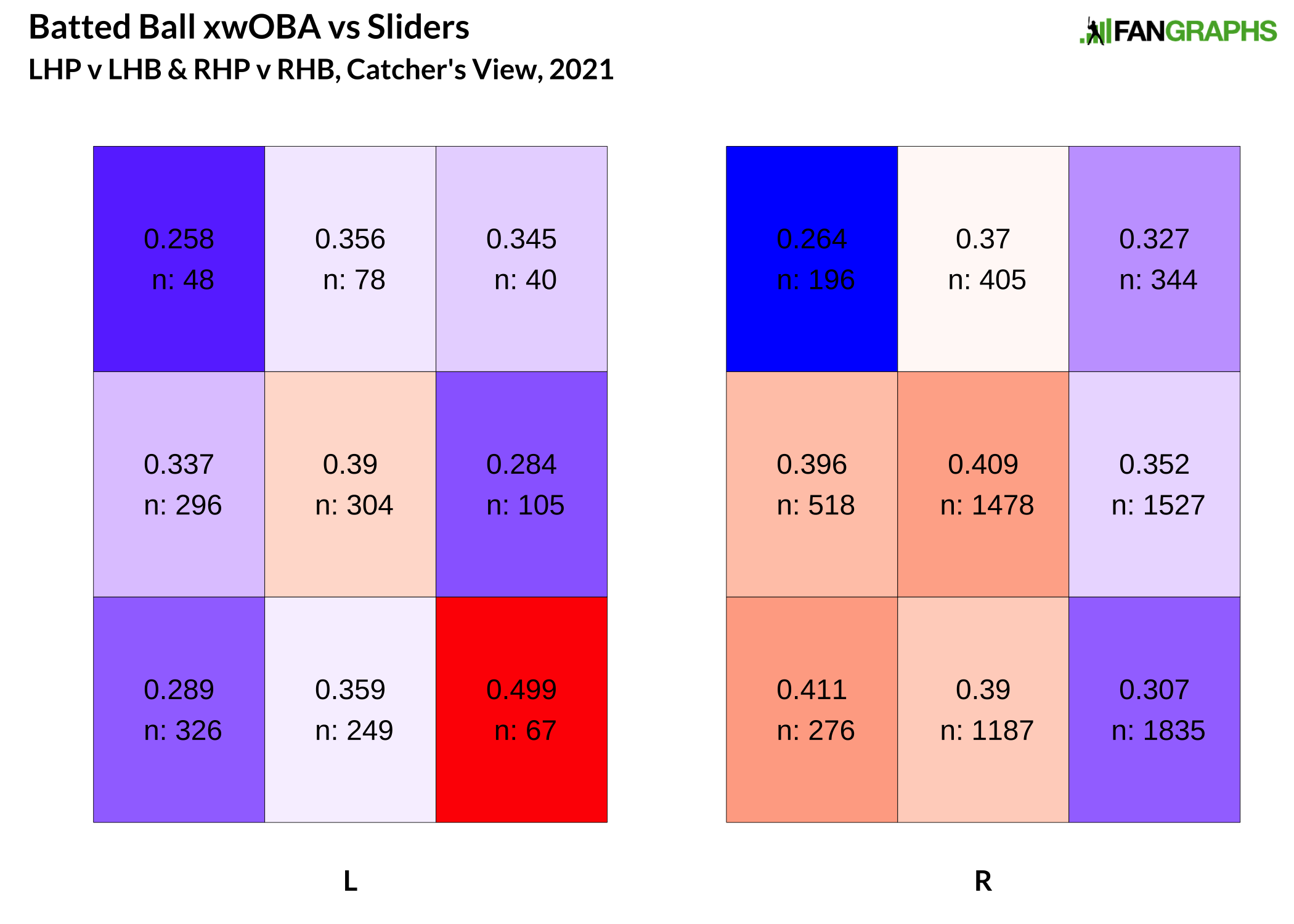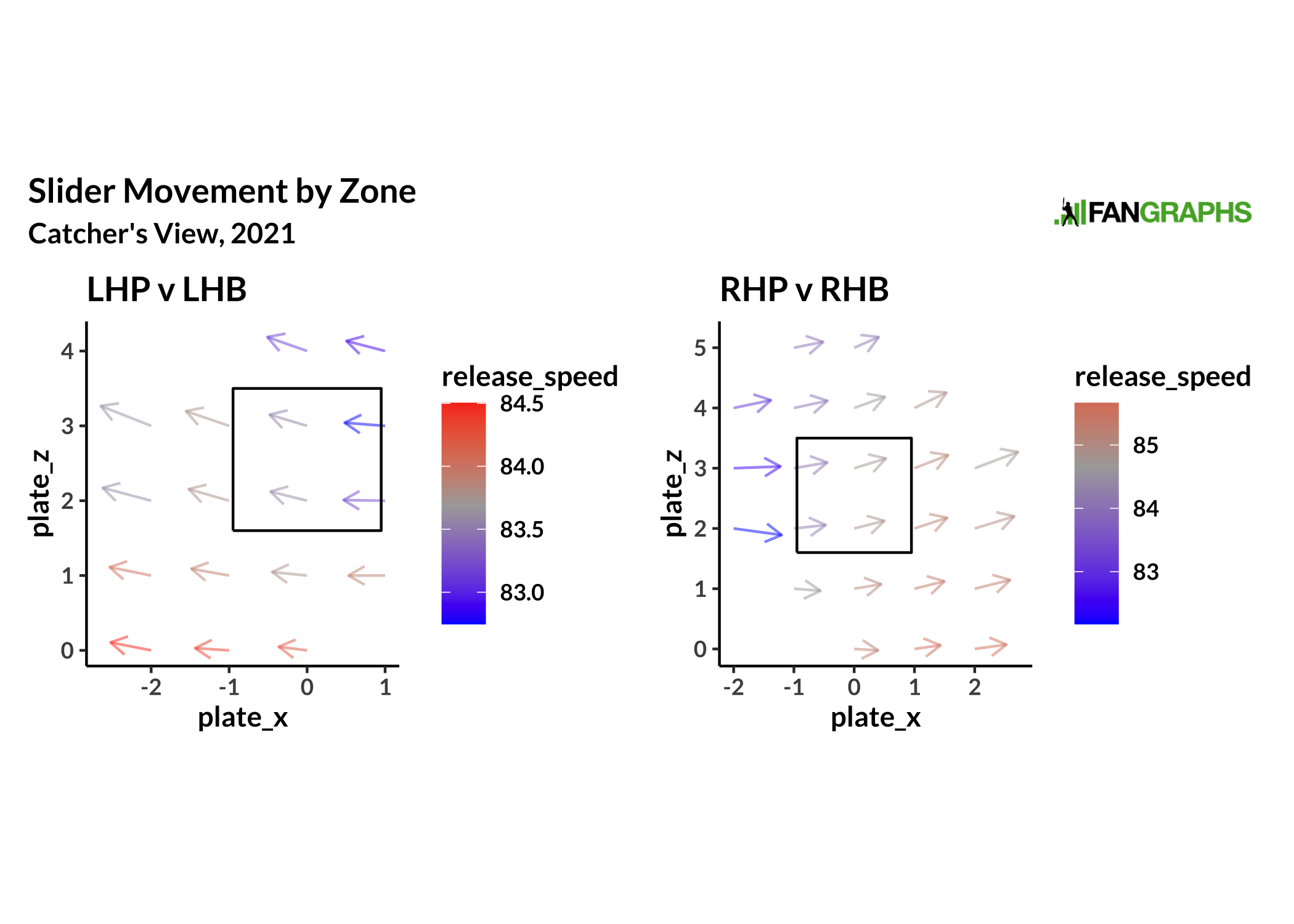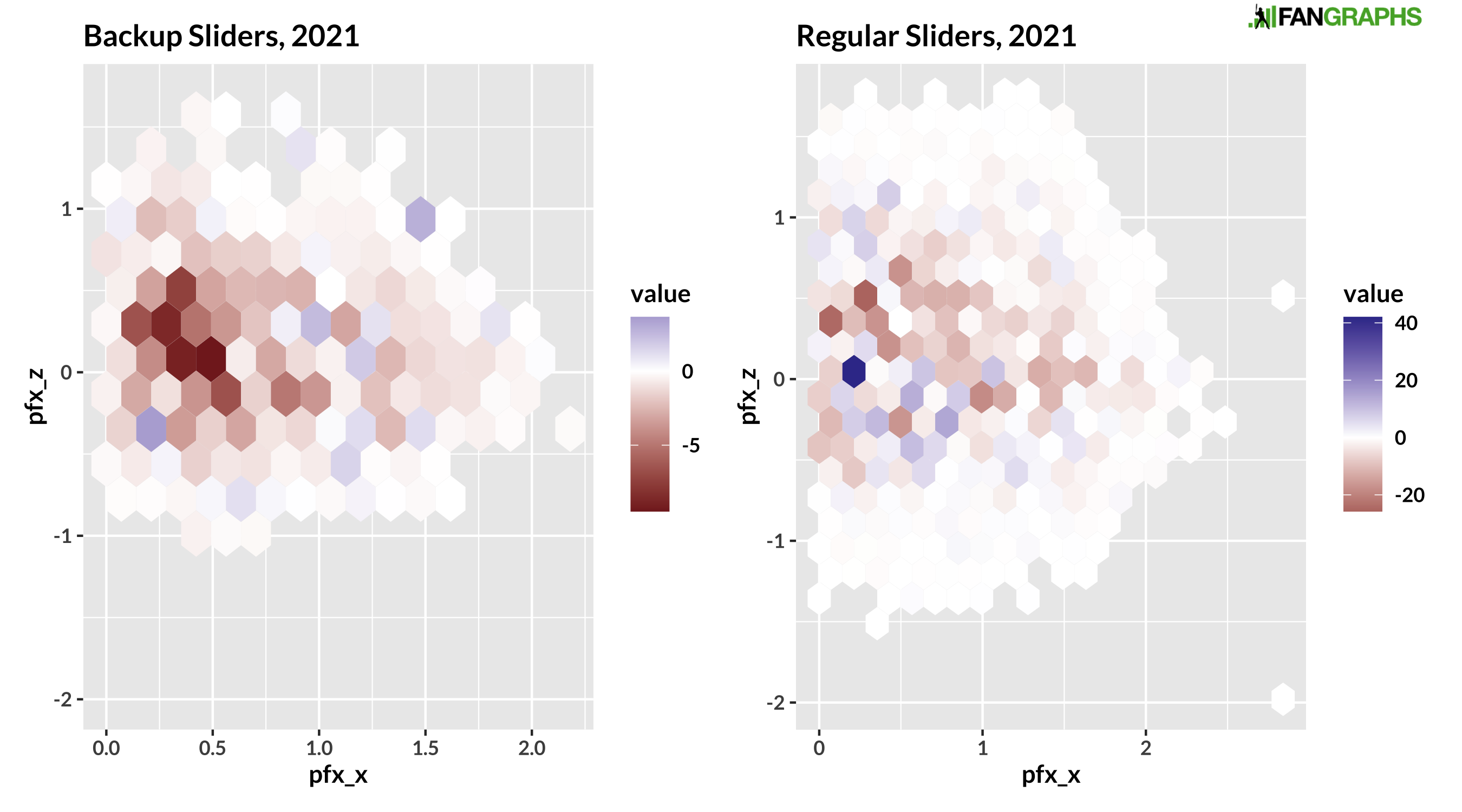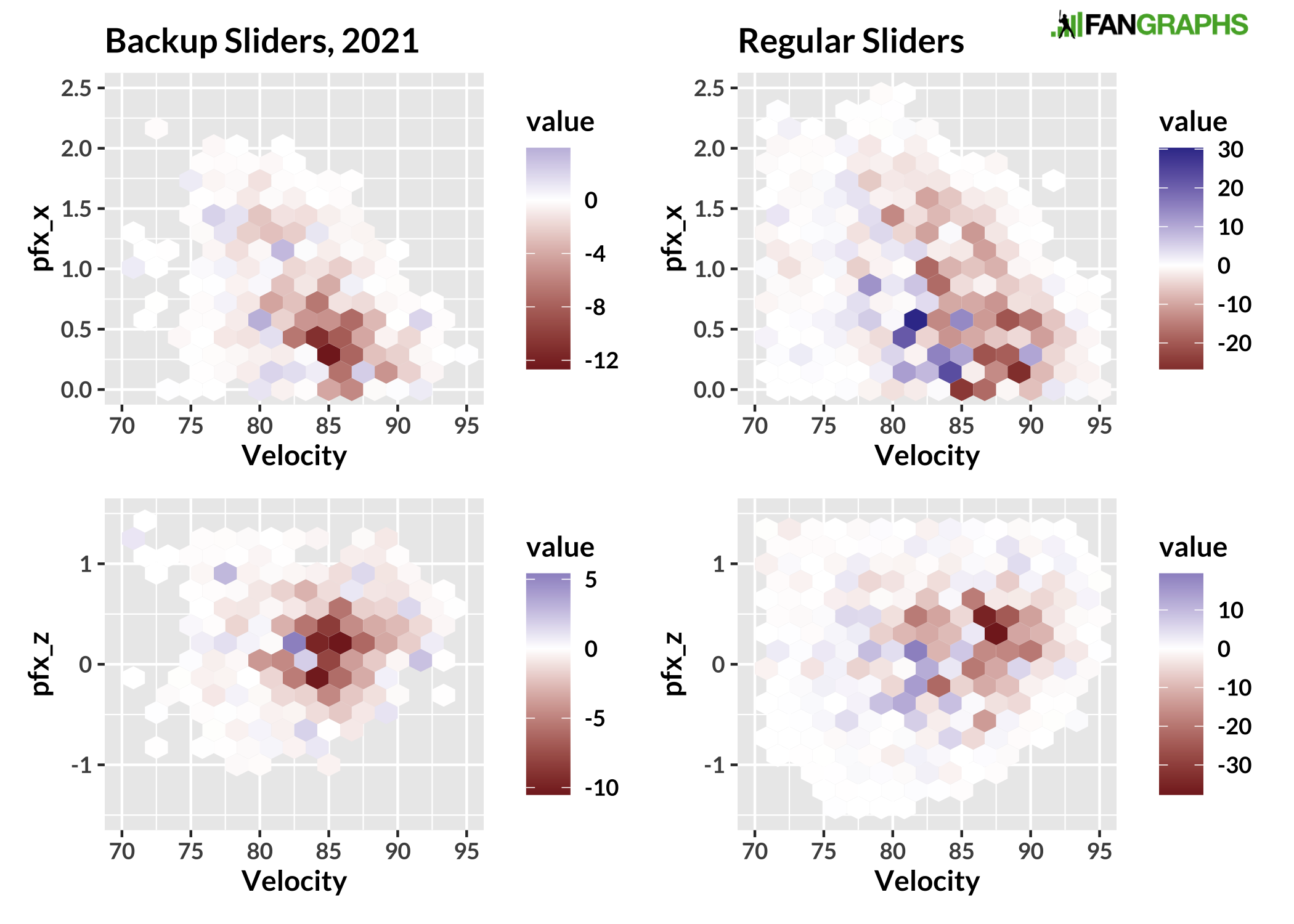A Cursory Investigation of the Backup Slider
I wish I could come to you with news about the mass adoption of backup sliders from pitchers across the league. I also wish I could come to you with a shining example of even one player who has perfected the art of the effective mistake. There is no apparent analytical case that comes to mind; it’s largely just a fascination to me — the best hitters in the world swinging through the worst offering a pitcher could imagine throwing. Here’s an example:
Matt Wisler is the perfect guy to have here — someone who throws nothing but sliders making the biggest kind of slider mistake! And yet there are times when it just works. What I want to try to answer is what makes these mistake sliders click without diving into the rabbit hole of pitch sequencing. Are there particular characteristics of movement and velocity that make for better backup sliders?
First, we have to set guidelines on what a backup slider is. You know it when you see it, but it is more broadly defined as something that “hangs” when thrown to a batter of the same handedness. Sliders behave differently depending on whether they’re thrown inside or out, as shown by Eno Sarris on this site a few years back; those away gain almost half a foot of horizontal movement compared to ones thrown inside! Sliders need height to be considered mistakes, but the distinctions in horizontal movement are too vast for an outside-and-up slider to be as bad a mistake as one up but inside. For our purposes, let’s say that a backup slider is anything in the upper third of the strike zone, middle-to-in, in a same handedness matchup.
With those parameters set, there have been some 3,900 backup sliders thrown this year, with a .338 xwOBA allowed on balls in play. That’s frankly not bad considering damage given up on same handedness sliders in the zone.

There’s nothing crazy or unexpected about the hot zones, though there’s a smaller sample of left-on-left matchups. The right-on-right matchups, though, give some sense of robustness. You could picture this being the xwOBA figures over a multi-year sample size, and yet there is the up-and-in pitch to lefties and righties generating weak contact. Maybe it’s incorrect to assume that the middle-up slider for either left-on-left or right-on-right matchups is necessarily a backup.
Before we go any further, it’s important to know how vertical movement changes on these sliders, in addition to the horizontal movement I already mentioned.

The direction and length of the arrows are the Statcast pitch movement measures at different locations in the zone, so while we see arrows pointing up, just know that these sliders still have drop. It’s subtle, but you can see the arrows pointing up a little more as you move further away from the pitcher’s arm side. That indicates that we do see a tad more vertical drop and lose some of that horizontal movement when compared to a pitch thrown on the outer third of the plate. As our own David Laurila has teased out of players and coaches before, that may be a matter of hand positioning that is causing more gyro spin, taking away from horizontal movement.
So there are differences in movement at large when throwing sliders to different parts of the zone, but it’s worth looking at the movement of the backup sliders that generated the lowest (aka better) run values. Pitch movements are taken from Statcast and measured in feet.

There’s a great deal of perceived safety for backup sliders here — not that there are many safe movement profiles, but there is a stark lack of clusters with negative run values. The one just below the zero mark of vertical movement for regular sliders doesn’t really appear for backups. This is more than two-dimensional; the other piece of this puzzle is velocity.

It’s hard to imagine that having more velocity would hurt pitchers, but in this instance, it seems as if backup sliders don’t need the same kind of velocity as regular sliders to be effective. Velocity is a great differentiator, but standout movement either horizontally or vertically can paper over those issues.
Those pitch movements seem to show that the performance of a backup slider is driven by it being a surprise pitch. But there may be something else when it comes to the movement. From David’s piece:
Jason Bere had an interesting observation about Joe Borowski, who saved 45 games for the Indians in 2007. According to Bere – currently Cleveland’s bullpen coach – Borowski threw a lot of backup sliders. Contrary to what you might think, that was a good thing.
“A lot of times when he got a guy to swing and miss, it was with the one that just kind of stayed,” Bere told me. “They would react to what they were seeing out of the hand, the spin, but while it had the tightness of a true slider, it didn’t break like one.
“Hitters will tell you that something that backs up on them is hard to hit. A hanger, they’ll crush. But something that backs up — that last second it’s not going where they thought it was going to go — they”ll have trouble with it. You can see it from the swings they take.”
It’s possible that hitters perceive movement differently at different parts of the zone, and that the subtle differences in slider movement are amplified to an extent.
I may not be qualified enough to read swings, but seeing a hitter swing under an offspeed pitch doesn’t feel normal, and seeing swings like this one say more than a pitch having relatively above-average movement.
I mentioned earlier that I didn’t want to open the Pandora’s Box of pitch sequencing, but it’s hard to imagine a thorough investigation of the backup slider that doesn’t lead to that end. It could just be that it’s something a hitter never suspects. (I’m afraid I’ve created more questions for myself than I can answer.) But I don’t think pitchers should try to throw backup sliders, unless they have elite command, as hitters still largely own the parts of the zone around those locations. To keep things in perspective, the sum total of the league’s best backup sliders by movement is something on par in value to all of Austin Adams’ sliders this year — a a small slice in the pitching world.
Either way, though, it’s fascinating to me is that a pitch so unintentional on all fronts can still work. You can see in the GIF above Salvador Perez positioning himself for a pitch low and outside, only for Mike Minor to miss in as poor a location as possible; it’s a slider that he knows won’t move like he wants it to. Yet its location with that movement is something the batter probably never visualized. The result is Zack Collins having to pull his hands in and swinging under it — an accidental victory for Minor.
In some theoretical baseball world, backup sliders are an effective weapon. For now, there’s much more beyond the surface that has to be understood first.
Owen is a contributor at FanGraphs. He got his start blogging about baseball when he was in college and you can find him maybe talking about something on Twitter @O_dotco.
It seems like there should be a place for a pitch that looks a lot like a fastball that might run into your thigh, but then clips the inside corner instead.
Yes! That’s what I was thinking. A sort of “front foot” slider. I’m guessing most pitchers don’t have the command or confidence to aim at a players waist and make it break in to the zone, and that’s why these become backup sliders instead.
Who has the best slider command in the league? Is there someone who does this?